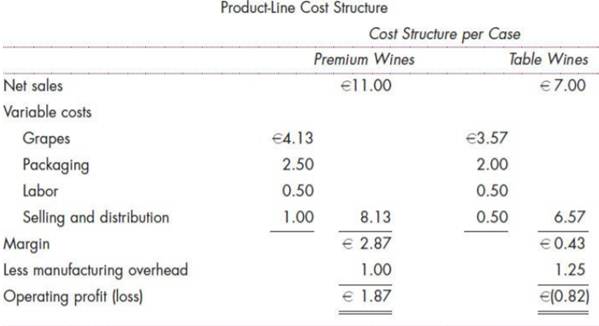Carlos Sanguini S.p.a. makes Italian premium wines and table wines. Grapes are crushed and the free-flowing juice and the first-pressing juice are made into the premium wines (bottles with corks). The second- and third-pressing juices are made into table wines (bottles with screw tops). The following data summarize operations for the year:


a. Grape costs represent the cost of the juice placed into the two product categories and are calculated as:

Note: A greater quantity of juice is required per case of premium wine than per case of table wine because there is more shrinkage in the premium wines than in table wines.
b. Each product has its own selling and distribution (S&D) organization. Two-thirds of selling and distribution expenditures vary with cases produced. The remainder of the expenditures does not vary with output.
Exhibit 2 provides a breakdown of the manufacturing overhead expenses into general winery costs and production facilities costs.

a General winery costs do not vary with the number of cases or number of product lines. These costs are allocated based on cases produced. b One-fourth of total production facilities costs varies with cases produced. The remainder is fixed costs previously incurred to provide the production capacity. Based on Exhibits 1 and 2, the accounting department prepared the following report:
Exhibit 3

Upper management was concerned that the table wines had such a low margin and some managers urged that these lines be dropped. Competition kept the price down at the €7.00 per case level. This information caused some managers to question how the competition could afford to sell the wine at this price. Before making a final decision, upper management asked for an analysis of the fixed and variable costs by product line and their break-even points. When management saw Exhibit 4, the President remarked, “Well, this is the final nail in the coffin. We’d have to almost triple our sales of table wines just to break even. But we don’t have that kind of capacity. We’d have to buy new tanks, thereby driving up our fixed costs and breakeven points. This looks like a vicious circle. By next month, I want a detailed set of plans on what it will cost us to shut down our table wines.” Exhibit 5 summarizes the shutdown effects. Based on the data, what should management do?
Exhibit 4

Exhibit 5
1. No effect on the sale of premium wines is expected.
2. The juice being used in the table wines can be sold to bulk purchasers to use in fruit juices for €150,000 per year.
3. The table wine production facilities (tanks, refrigeration units, etc.) have no use in premium wine production. These facilities can be sold for €350,000, net of disposal costs.